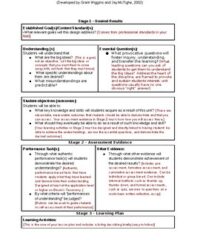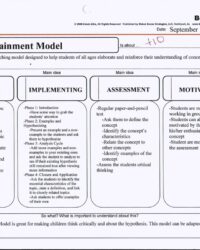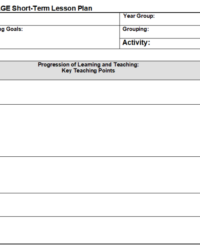Every educator knows the feeling: standing in front of a class, trying to spark genuine curiosity and deep understanding. It is a noble pursuit, yet sometimes, traditional lesson planning can feel more like a checklist than a blueprint for profound learning experiences. We often find ourselves asking, “Are my students truly grasping this, or are they just memorizing facts for a test?” This challenge highlights the need for a shift in how we approach our instructional design, moving beyond merely covering content to truly fostering enduring understanding.
That is where the concept of learning focused strategies comes into play. It is an approach that prioritizes student engagement, critical thinking, and the transfer of knowledge to new situations. Instead of simply delivering information, teachers become facilitators of discovery, guiding students through activities that require them to actively construct their own understanding. Crafting lessons that consistently achieve this requires a thoughtful framework, and that is precisely what a well-designed learning focused strategies lesson plan template can provide.
Embracing the Power of Learning Focused Instruction
Shifting to a learning focused paradigm means re-evaluating what success looks like in the classroom. It is less about how much material you cover and more about how deeply students engage with, process, and apply what they are learning. This approach acknowledges that true learning is an active, constructive process, not a passive reception of information. When lessons are designed with these strategies in mind, students are not just spectators; they are active participants in their educational journey, leading to more meaningful and lasting comprehension.
One of the primary benefits of this instructional philosophy is its ability to cultivate higher-order thinking skills. Rather than rote memorization, students are prompted to analyze, synthesize, evaluate, and create. This prepares them not only for academic success but also for the complex challenges of the real world, where critical thinking and problem-solving are paramount. It also fosters a more dynamic and engaging classroom environment, reducing passive learning and increasing student motivation.
Moreover, learning focused strategies inherently promote differentiation and inclusivity. By focusing on student understanding and varied pathways to knowledge, teachers can more easily adapt their instruction to meet the diverse needs of learners. This framework encourages educators to anticipate common misconceptions, provide multiple modes of engagement, and offer varied opportunities for students to demonstrate their learning, ensuring that every student has a chance to succeed.
Implementing these strategies requires deliberate planning. It is about setting clear, measurable learning objectives from the start, then designing activities that directly lead students towards achieving those objectives, rather than just covering content. Assessment, too, becomes an integral part of the learning process, offering feedback that guides further instruction and student improvement.
Key Pillars of a Learning Focused Lesson
To truly embody a learning focused approach, lessons should incorporate several essential elements. These elements work in synergy to create a comprehensive and effective learning experience.
- Clear Learning Objectives: What specifically should students know, understand, and be able to do by the end of the lesson? These should be visible and understood by both teacher and students.
- Engaging Hook or Activator: Begin with something that grabs students’ attention, connects to prior knowledge, and sets the stage for the new learning.
- Active Learning Strategies: Incorporate activities that require students to do something with the content (discuss, draw, write, solve, create) rather than just listen.
- Formative Assessment Throughout: Continuously check for understanding to inform instruction and provide timely feedback. This helps identify misconceptions early.
- Opportunities for Collaboration: Encourage students to work together, discuss ideas, and learn from their peers.
- Reflection and Closure: Provide time for students to synthesize what they have learned, connect it to bigger ideas, and ask questions.
- Differentiation: Plan for ways to support struggling learners and challenge advanced ones, ensuring all students can access and extend their learning.
Designing Your Effective Learning Focused Strategies Lesson Plan Template
Creating your own robust learning focused strategies lesson plan template is a powerful step towards more impactful teaching. It provides a consistent framework that ensures you consider all critical components of effective instruction every time you plan. Think of it as your personal blueprint for success, helping you move beyond simply listing activities to strategically designing pathways to deep understanding. This template is not a rigid cage but a flexible guide, allowing you to innovate while maintaining focus on student learning outcomes.
When you sit down to plan with a learning focused strategies lesson plan template, you are prompted to think about the “why” behind each activity, not just the “what.” This structured approach encourages you to anticipate student needs, potential difficulties, and moments for true intellectual growth. It helps you articulate clear objectives, select appropriate strategies, and design meaningful assessments that truly measure learning, all while considering the flow and engagement of the lesson for your students.
Ultimately, a well-crafted learning focused strategies lesson plan template empowers you to be more intentional and effective in your teaching. It streamlines the planning process while elevating the quality of your instruction, leading to more engaged students and more satisfying teaching experiences. It becomes a reliable tool in your pedagogical arsenal, ensuring that every lesson is purposeful and every moment in the classroom counts towards genuine student growth and mastery.
Here are key sections to include when developing your own template:
- Lesson Title and Subject
- Grade Level/Audience
- Time Allotment
- Learning Objectives (Student-friendly, measurable)
- Essential Questions (Guiding inquiry)
- Materials Needed
- Prior Knowledge/Connections
- Lesson Sequence/Procedures:
- Hook/Activator
- Mini-Lesson/Direct Instruction (if applicable)
- Guided Practice (Active Learning Strategies)
- Independent Practice/Application
- Closure/Reflection
- Differentiation Strategies (Support & Extension)
- Assessment (Formative & Summative)
- Teacher Reflection (What went well? What could be improved?)
By consistently employing a framework centered on learning focused strategies, educators can transform their classrooms into dynamic hubs of inquiry and discovery. This proactive approach to planning ensures that every minute of instruction is maximized for student growth, fostering not just knowledge acquisition but also the development of critical thinking and problem-solving skills that last a lifetime. It is about empowering students to become active participants in their education, ready to tackle complex challenges and contribute meaningfully to the world around them.
The commitment to designing lessons with a deep understanding of how students learn fundamentally elevates the teaching profession. It moves beyond simply delivering content to truly facilitating understanding, equipping learners with the tools they need to navigate an ever-changing landscape. This mindful approach to instruction creates a ripple effect, building confident, capable individuals who are prepared for continuous learning long after they leave the classroom.


